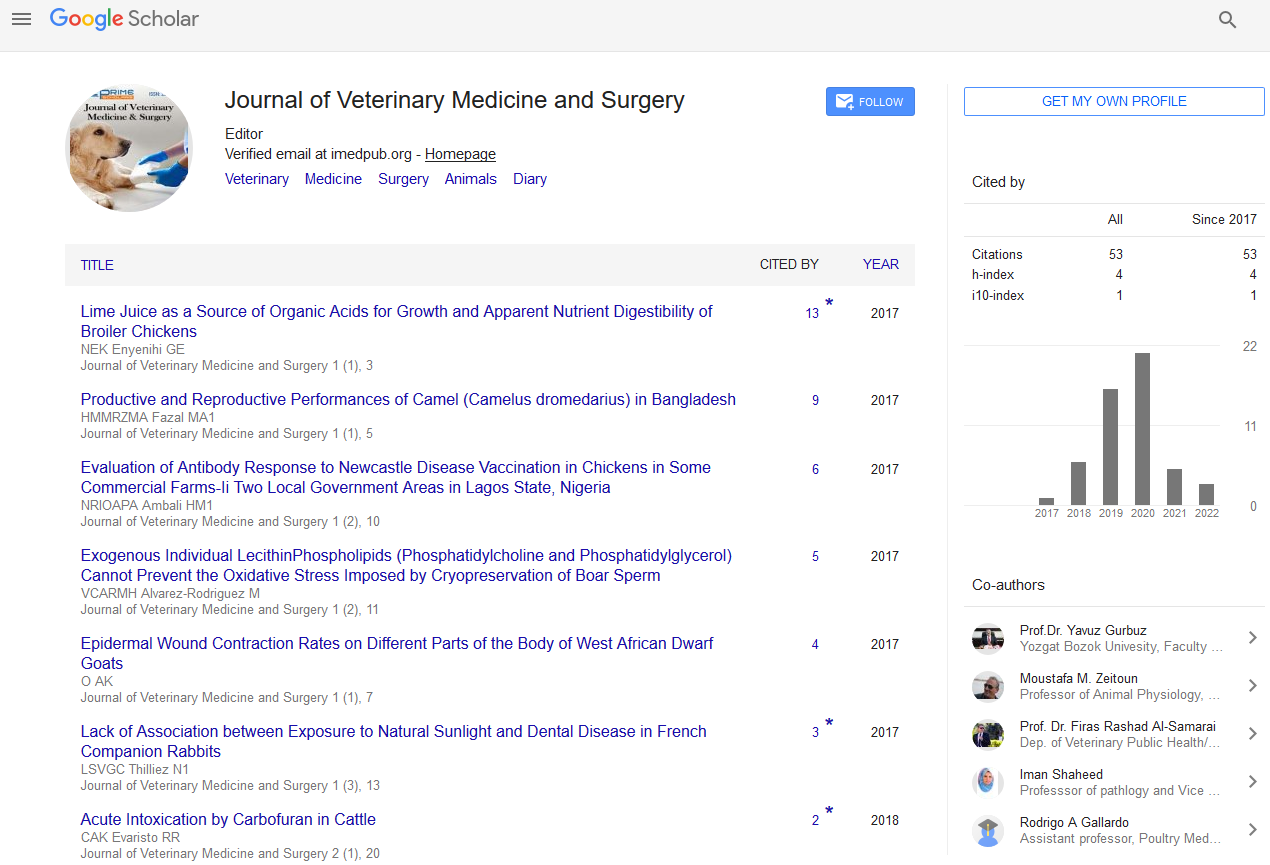Commentry - (2024) Volume 8, Issue 2
Understanding Hepatitis Virus in Animals: A Comprehensive Overview
Lizzie Josephina*
Department of Veterinary Medicine, Edge Hill University, UK
*Correspondence:
Lizzie Josephina,
Department of Veterinary Medicine, Edge Hill University,
UK,
Email:
Received: 29-May-2024, Manuscript No. IPJVMS-24-20555;
Editor assigned: 31-May-2024, Pre QC No. IPJVMS-24-20555 (PQ);
Reviewed: 14-Jun-2024, QC No. IPJVMS-24-20555;
Revised: 19-Jun-2024, Manuscript No. IPJVMS-24-20555 (R);
Published:
26-Jun-2024, DOI: 10.36648/2574-2868.8.2.15
Description
Hepatitis viruses are a diverse group of pathogens that cause
liver inflammation, commonly known as hepatitis. While much
of the public’s awareness focuses on human hepatitis viruses,
such as hepatitis A, B, C, D, and E, it is crucial to recognize
that hepatitis viruses also affect a wide range of animal
species. These infections can have significant implications for
veterinary health, animal welfare, and zoonotic transmission
to humans. This article provides an in-depth look at the
various hepatitis viruses affecting animals, their pathogenesis,
clinical manifestations, diagnosis, treatment, and preventive
measures. Hepatitis viruses in animals are primarily divided
into different families based on their genetic material and
structural characteristics. The most well-known families include
Hepadnaviridae, Flaviviridae, and Picornaviridae. These viruses
can infect a wide range of animal species, including mammals,
birds, reptiles, and fish. Understanding these viruses’ biology,
epidemiology, and impact is essential for managing animal
health and preventing potential spillover to human populations.
The Hepadnaviridae family includes the Hepatitis B virus
(HBV) and its related counterparts in animals, such as the
Woodchuck Hepatitis Virus (WHV), Ground Squirrel Hepatitis
Virus (GSHV), and Duck Hepatitis B Virus (DHBV). These viruses
are DNA viruses with a partially double-stranded genome
and a unique replication cycle involving reverse transcription.
Woodchuck Hepatitis Virus (WHV) infects woodchucks and
serves as an important model for studying HBV infection
and hepatocarcinogenesis. WHV causes chronic hepatitis in
woodchucks, leading to the development of Hepatocellular
Carcinoma (HCC), similar to HBV in humans. Research on WHV
has provided significant insights into the mechanisms of viral
replication, host immune response, and oncogenesis. Duck
Hepatitis B Virus (DHBV) infects domestic ducks and is closely
related to human HBV. DHBV is used extensively in research to
understand HBV pathogenesis and develop antiviral therapies.
Infected ducks exhibit liver inflammation, necrosis, and in
some cases, liver tumors. Studying DHBV has contributed to
developing vaccines and antiviral agents for HBV in humans.
The Flaviviridae family includes several viruses that cause
hepatitis in animals, including the Hepatitis C Virus (HCV) and
its counterparts in non-human primates and other animals.
Hepatitis C Virus (HCV) primarily infects humans, but closely
related viruses have been identified in non-human primates,
such as chimpanzees. These animals are often used in research
to study HCV infection, immune response, and antiviral
treatments. The pathogenesis of HCV in non-human primates
mirrors that in humans, leading to chronic hepatitis and liver
cirrhosis. Bovine Viral Diarrhea Virus (BVDV) infects cattle and
belongs to the Pestivirus genus within the Flaviviridae family.
BVDV can cause a range of clinical manifestations, from mild
asymptomatic infections to severe disease characterized
by diarrhea, respiratory issues, and reproductive failures.
One of the most significant impacts of BVDV infection is the
development of mucosal disease, which results in severe
ulceration of the gastrointestinal tract and is often fatal. Avian
Hepatitis E Virus (HEV) infects chickens and is genetically
distinct from mammalian HEV. Avian HEV causes hepatitissplenomegaly
syndrome, leading to liver inflammation, spleen
enlargement, and mortality in infected birds. Understanding
avian HEV is crucial for poultry health and biosecurity. Several
picornaviruses have been identified in horses, causing hepatitislike
symptoms. Equine Hepacivirus (EqHV) and Non-Primate
Hepacivirus (NPHV) are two such examples. These viruses are
closely related to HCV and can cause liver inflammation and
chronic hepatitis in horses.
Acknowledgement
None.
Conflict Of Interest
None.
Citation: Josephina L (2024) Understanding Hepatitis Virus in Animals: A Comprehensive Overview. J Veterinary Med. 8:15.
Copyright: © 2024 Josephina L. This is an open-access article distributed under the terms of the Creative Commons Attribution License, which permits unrestricted use, distribution, and reproduction in any medium, provided the original author and source are credited.

